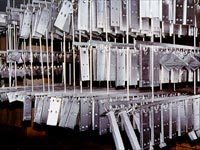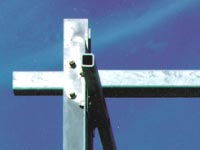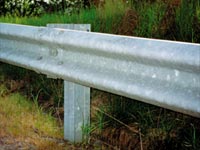Painting Hot-Dippped Galvanized Steel
Painting galvanized steel requires careful preparation and a good understanding of both painting and galvanizing. Many products have been galvanized and painted successfully for decades, including automobiles and utility towers. Past experience provides excellent historical data for how best to achieve good adhesion. By studying past adhesion failures and successes, galvanizers, paint companies, researchers, paint contractors, and other sources have created an ASTM specification (ASTM D 6386) detailing the process and procedures for preparing hot dip galvanized steel for painting. When the galvanized surface is prepared correctly, paint adhesion is excellent and the duplex system becomes an even more successful method of corrosion protection.
Galvanized steel can be divided into three categories: newly-galvanized steel, partially weathered galvanized steel, and fully weathered galvanized steel. Each type of galvanized steel must be prepared differently because the galvanized surface has different characteristics at each stage of weathering. It is important to know the age of the galvanized steel that will be painted. Different paint selections are also important to know.
Newly-Galvanized Steel

Newly-galvanized steel is zinc-coated steel that has been hot-dip galvanized after fabrication within the past 48 hours. The newly-galvanized steel should not be water or chromate quenched, nor should it be oiled.
This type of galvanized surface is typically very smooth and the surface may need to be slightly roughened – using one of the profiling methods described in this publication – to improve paint adhesion. A newly galvanized surface has little or no zinc oxides or zinc hydroxides, so no major cleaning is necessary.
Partially Weathered Galvanized Steel
Partially weathered galvanized steel is classified as steel that has been galvanized more than 48 hours ago but has been in service for less than two years. At this stage in the life of the galvanized steel, the formation of zinc corrosion products is evident by a light white film present on the galvanized steel. This layer of oxidation must be removed to promote good adhesion between the paint and the galvanized steel. Cleaning of the light corrosion products can be done using many methods mentioned below.

Before painting partially weathered galvanized steel, it is important to know if the coating was chromate quenched. Spot testing the galvanized steel according to ASTM B 201 can determine the presence of chromate conversion coatings. If a chromate coating is detected, the chromate layer must be removed, either by brushing off by abrasive blast cleaning, abrading, sanding or allowing the steel to weather for six months.
Partially weathered galvanized steel also should be slightly roughened to improve paint adhesion. Any of the surface profiling methods described below can be used to prepare the surface.
Fully Weathered Galvanized Steel

Fully weathered galvanized steel has been in service for approximately two years and has completely formed the protective layer of corrosion products known as the zinc patina. The patina has a very stable and finely etched surface, which provides excellent paint adhesion. The only surface preparation needed is a warm water power wash to remove loose particles from the surface. In order to protect the surface, the power wash should not exceed 1450 psi. Allow the surface to completely dry before application of the paint system.
Related References:
1. About Zinc
2. About Hot-Dip Galvanizing
3. HDG Hot-Dip Galvanizing Last Time
4. Cost of Galvanized Steel
5. Selection of Zinc Coatings
6. Zinc Coatings-Galvanized|Electrogalvanized|Galvanneal|Galfan
7. Physical Properties of HDG Hot-Dip Galvanized
8. HDG Hot-Dip Galvanized Abrasion Resistance Resistance to Mechanical Damage
9. Hot-Dip Galvanized Corrosion Protection and the Zinc Patina
10. HDG Hot-Dip Galvanized High Temperature Exposure
11. HDG Hot-Dip Galvanized Surface Reflectivity
12. HDG Hot Dip Galvanized Coating Structure
13. HDG Hot Dip Galvanized Bond Strength
14. HDG Hot Dip Galvanized Coating Uniformity
15. HDG Hot Dip Galvanized Coating Thickness
16. Powder Coating Hot Dipped Galvanized Steel
17. Painting Hot-Dippped Galvanized Steel
18. Painting Hot-Dipped Galvanized Steel Surface Preparation
19. Surface Coatings for Corrosion
20. Hot-Dip Galvanizing Surface Preparation
21. Hot-Dip Galvanizing Galvanizing
22. Hot-Dip Galvanizing Inspection
23. Characteristics of Zinc
24. Hot-Dip Galvanizing Performance in Atmosphere
25. Hot-Dip Galvanizing in Atmosphere Time to First Maintenance
26. Hot-Dip Galvanizing Performance in Soil
27. Soil Corrosion Data for Corrugated Steel Pipe
28. Hot-Dip Galvanizing Performance in Water
29. Cause of Zinc Corrosion
30. Corrosion of Zinc Coated Steel in Selected Natural Fresh Water
31. Corrosion of Zinc and Zinc Coated Steel in Sea Water
32. Corrosion of Zinc Coating in Industrial and Domestic Water
33. Concrete Corrosion of Hot Dip Galvanizing
34. Concrete corrosion resistance of hot dip galvanized reinforcing
35. Removal of Forms Concrete Corrosion
36. Zinc Reaction in Concrete Corrosion
37. Concrete Corrosion References
38. Hot-Dip Galvanizing Performance in Chemical Solutions
39.Hot-Dip Galvanizing Performance in Contact with Other Metals
40. Hot-Dip Galvanizing Performance in contact with Treated Wood
41. Hot-Dip Galvanizing Performance in contact with Food
42. Hot-Dip Galvanizing Performance in Extreme Temperature
|
